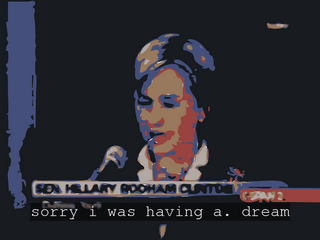This was pre - "8 BIT" documentary; if I wrote it now it would be at least 3 times longer and even more geeky. Yard (which looked great and had plenty of interesting artist writing in it) didn't circulate much, so I figured it would be nice to share some of this content. Some info/url's could have changed since; I'll try to make updates, and by all means feel free to help:). It is also the pre-editor version so please excuse possible errors. Most images are from vertexList performances, and were not included in the original article. The bottom updates section is current info added by various involved parties:)
Gameboys (and Gamegirls) (fragments)
By Marcin RamockiMy first encounter with chiptunes occurred in 2003, when Bubblyfish and Nullsleep performed at
vertexList in Brooklyn. It was “love at first sight” and I knew immediately I was dealing with far more than a bunch of lo-fi, Mario-esque bleeps and beeps. The experience was fresh and aesthetic, liberating in its radical simplicity and grace. The sounds I heard didn’t pretend to be anything but low-bit electronic signals, making me aware of speaker membranes, circuits of electricity, zeroes and ones. At the same time the melodies produced with those zeroes and ones were personal, emotional, sometimes nostalgic, and at times silly.
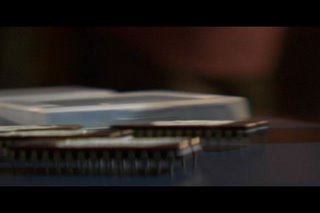 NES chips
NES chips
Chiptunes (or micromusic) are essentially sound pieces created with existing sound engines of early personal computers and video game systems. The first chiptuners used the Atari and Commodore assembly language to communicate directly with the electronic chip responsible for sound generation and wrote codes that executed their compositions. Then came Atari trackers which made things a bit simpler:
http://dhs.nu/files_msx.php ). The pioneers of chiptune music,
Bodenständig 2000 (Bernhard Kirsch and Dragan Espenschied; www.bodenstaendig.de) and
8 Bit Construction Set (
Paul Davis,
Cory Arcangel, Joe Beuckman and Joe Bonn) came up with their first respective records in 1999 and 2000, but the concept of direct computer sound hack went further back. There is a definite link between the origins of chip music and so called “demos”, which were hacked animated game sequences sometimes containing music. A demo party of teenage geeks is most likely where the first chiptune happened, induced by sleepless nights of coding and gallons of Mountain Dew.
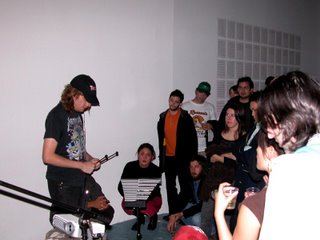 Cory Arcangel performing his glockenspiel-Springsteen piece.
Cory Arcangel performing his glockenspiel-Springsteen piece.The defining moment for the whole micromusic scene was the introduction of “Little sound DJ” by
Johan Kotlinski in Sweden (www.littlesounddj.com, 2000) and “Nanoloop” by
Oliver Wittchof in Germany (www.nanoloop.de, 2000). Both are informal softwares produced with Nintendo Software Development Kit, which opened the Game Boy Classic to all musicians interested in the chiptune aesthetics. The fact that writing for Game Boy no longer required the knowledge of clandestine computer codes and the appeal of having a hand-held, inexpensive instrument-like device attracted artist from all areas of musical trade. Game Boy music blossomed in Austria, Switzerland, France, throughout northern Europe, UK, USA and Japan. Micromusic naturally attracted gamers, computer geeks and sophisticated hipsters. It thrived in underground clubs and art galleries.
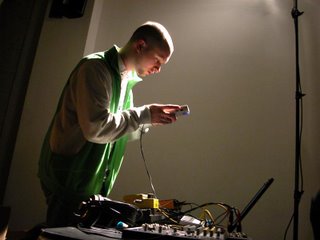 Johan Kotlinski (role model)
Johan Kotlinski (role model)Many analogue-heads don’t understand the technical concept of making music on Game Boy and confuse it with sampling video-game tunes. This couldn’t be less accurate. Working with a Game Boy tracker is a very complex composition process; perhaps much more demanding because of its “bare bones” sound library and minimal interfacing. For the sake of my research I got a used, Game Boy classic ($20) at a vintage Saint Mark’s videogame store and loaded it with a LSDJ cartridge. You most likely will be stuck with an emulator or a ROM image: very few cartridges were actually printed by Johan. Some occasionally surface on EBay or on gamer Internet forums, ranging from $100 to $200.
Due to the limited amount of buttons (8) on a Game Boy, the composition process is broken into modular segments. So first you enter a “song screen”, pick a channel, go on to a “chain screen” where you plant a numeric symbol for a fragment, and finally, on the “phrase screen” you get to pick the progression of your notes or drum beats. The phrases make up a chain, which fill 4 tracks of a song. The finished song is stored on the cartridge. There are also other screens where you get to customize the sounds, pick pre-selected drum kits, change tempo or even build sounds using a waveform modulator. For a full tutorial check out Nullsleep at
www.8bitpeoples/lsdjtutorial. It took me approximately 10 hours of messing around to create something sounding like a funky baseline from the 70’s, with a drum and unidentified techno-chirping in the background.
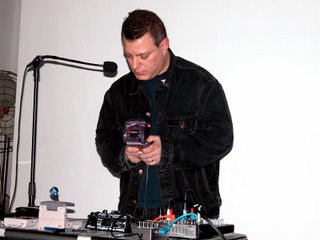 Jeremy Kolosine (Receptors)
Jeremy Kolosine (Receptors)A Game Boy music performance begins with a musician plugging the mini-jack of their Game Boy (or a couple of linked Game Boys) to an amp, selecting a song and pressing the “start” button. Since the playback device is a tracker as well as a storage unit, the tunes can be modified in real-time, which makes room for improvisation and human error. Some performers attempt singing along with their Game Boy, which triples the human error factor. After all it is hard to sing while watching the tiny screen full of dashing 2-bit numbers and remembering to press the right button at the right time.
 David Kristian
David Kristian The NYC chiptune scene is definitely happening and, as far as I know, the biggest in the US, mostly due to constant influx of visiting performers. You can find a Game Boy performance practically every week somewhere in the city. Some of the favorite locations include Share (which is a traveling new media showcase), Psychastenia Society, Gamers’ Nite Groove, the Tank, Tonic, Remote Lounge, vertexList, Galapagos, Monkeytown and occasionally big events like the Lincoln Center performance or Cory Arcangel - curated chiptune extravaganza at the Deitch Projects. Some of the locals include Bitshifter, Bubblyfish, Glomag, Nullsleep, and of course Cory, who recently shifted his creative output toward gallery exhibiting and curating. Each of these wonderful people brings their own unique style to micromusic and makes living in NYC so much more fun.
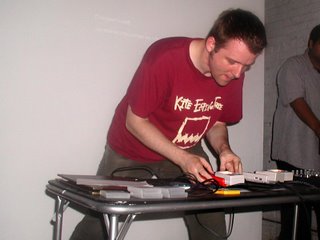 Josh Davis (Bit Shifter)Josh Davis (aka Bit Shifter)
Josh Davis (Bit Shifter)Josh Davis (aka Bit Shifter) is an ex-punk rocker guitar player with a tremendous ability to animate the audience. While extremely polite and almost shy in person, Bitshifter comes to life when connected to a Game Boy, pumping the audience with adrenaline-loaded, hardcore, yet not techno-ey sound (check out “The Connector Conspiracy”), just to bring them back for a therapeutic and almost Baroque break with “The March of Nucleotides”. Track Josh at his website www.bit.shifter.net.
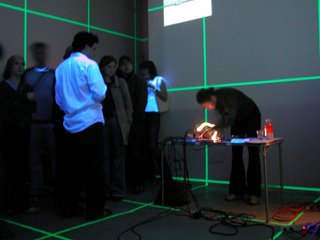 Haeyong Kim (Bubblyfish)
Haeyong Kim (Bubblyfish)
The only girl on the NY team,
Haeyong Kim (aka Bubblyfish) brings to the table a classical piano background mixed with an incredible emotional sensibility. Honest and riveting, Haeyoung’s pieces totally transfigure their electronic medium to resonate as powerful existential statements. If I were to pick one of her pieces it would definitely be “Translucent”, which still doesn’t fail to send an aesthetic chill down my spine. Once told that she was not bubbly enough to keep a corporate job (thus the origin of her stage name), she now gets recognition from Malcolm McLaren to the Centre Pompidour in Paris. Check out her mp3s at www.bubblyfish.com.
 Chris Burke (Glomag)Chris Burke (aka Glomag)
Chris Burke (Glomag)Chris Burke (aka Glomag) entered the 8-bit universe as a fully formed, gifted electronic musician and a sound engineer. His superior artistic discipline and sophisticated taste in music consistently challenge the limits of the Game Boy sound capacity. Chris mentioned during our interview that he finds the minimalism of chiptunes challenging and limiting, but it is specifically this limitation that liberates him to fully embrace and reconnect himself emotionally with the material. My picks would include an older piece “Vertov” and the newer, Joy Division cover “Disorder”.
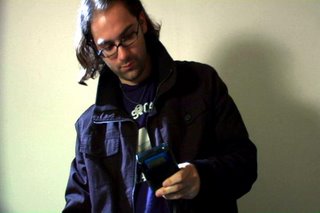 Jeremiah Johnson (Nullsleep)
Jeremiah Johnson (Nullsleep)Despite of his young age
Nullsleep (Jeremiah Johnson) is one of the chiptune veterans, not only in NY but globally. Ivy educated hacker and software developer, Jeremiah plays the Nintendo Entertainment System, Game Boy, Atari and is known to jam on his shoulder-strapped keyboard like on a solo guitar. His recent performance at Deitch Projects was a real treat: high-energy bleeporama with a hard-rock attitude, bouncing fans and a giant demo projections in the background. The Depeche Mode Megamix is an absolute must hear (www.8bitpeoples/nullsleep).
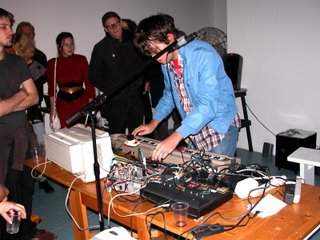 Paul Slocum (Treewave)
Paul Slocum (Treewave) Some other awesome Americans include
Mark Denardo (who recently moved to NYC from Chicago; www.markdenardo.com ), Handheld (one of my big time favorites: “Wiggle” makes me feel like a confused, but very happy ant on speed; http://artists.iuma.com/IUMA/Bands/handheld/),
Bud Melvin (www.budmelvin.com ) ,
Tree-Wave (chiptune duo from Dallas with an amazing dot-matrix printer hacked to be a drum; www.treewave.com),
Trash 80 from San Francisco (www.trash80.net), Baltimore based
Hey Kid Nice Robot (http://the-never.net/hknr.html) and Naughtyboy and
8Bit Weapon from LA (www.8bitweapon.com).
Across the Atlantic Ocean there is a whole giant universe of chiptune activity. Mentioning all would be beyond the scope of this article, but I would like to outline a very general geographic map of micromusic. Starting in Vienna, which is a major European Game Boy hub, we will find Game Boy Music Club (www.gameboymusicclub.org),
Herbert Wiexelbaum (this guy is totally fantastic, don’t miss “My sound is little, my day is gee”; http://members.chello.at/herbert_weixelbaum/),
Markus Schrodt ,
Schaua , Irene Grabherr and Meike Randow (featured by The Game Boy Music Club).
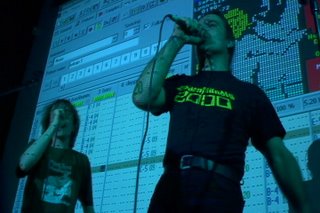 Bodenständing 2000 (image from Deitch Projects concert curated by Cory Arcangel)
Bodenständing 2000 (image from Deitch Projects concert curated by Cory Arcangel)Germany is the homeland of the original Atari rockers Bodenständing 2000. I have seen their live NY concert and I have to say, I haven’t had so much fun since high school. Genuinely hilarious and human, they rap goofy songs about the computer geek existence to the background of a deep-base 8-bit Atari track, occasionally break out a flute or a tiny plastic keyboard and go all analogue. From the same neighborhood check out the Game Boy musician
Firestarter.
Another big chiptune city, Stockholm is represented by
Role Model (aka Johan Kotlinski, the designer of LSDJ; or www.rebelpetset.com ). As one may expect Johan really knows his gear and puts out some nice post-disco pieces, I particularly enjoyed “kinetiskt porslin” and “snare rush disco”. While you are freezing your arse off in Stockholm don’t miss
Goto80 and
Covox.
The list wouldn’t be even close to complete without
Lektrogirl in London,
Lo-Bat in Brussels, Gameboyzz Orchestra in Poland (http://gameboyzz.terra.pl), Finnish Huoratron (www.huoratron.com) and last but not the least
Teamtendo of Paris, who refuse to be interviewed without their furry animal costumes, attack camera-men during performances and play solid, wacky music on Game Boy-camera synthesizer. For more music and great info about chiptunes go to
www.micromusic.net, a web based label and a fantastic community database with 11 city headquarters.
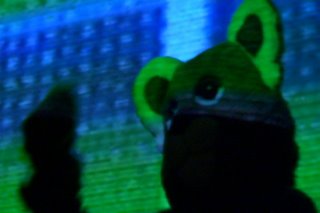 Teamtendo (screen capture from 8 BIT documentary)
Teamtendo (screen capture from 8 BIT documentary)It probably comes as no surprise that there are plenty of folks with Game Boys in Japan. Just a couple of weeks ago I heard
Motoki Tsushima (aka Aonami; ) play Game Boy at the
Tank in NY ( ); he played only two pieces because of some technical issues, but what I heard was excellent. Classic, well put together and entertaining chiptune party with some interesting voice sampling. Equally highly recommended are
cow’p,
K-> and
Blasterhead .
------------------------------------------------------------------------------------------------------------------
Update #1
Here is a comment from
Paul Davis (
Beige Records) about the early days of chiptunes and
the "8 Bit Construction Set", a DJ battle record made with Commodore 64 and Atari 800.
This is before people made music on gameboys (but not much before).
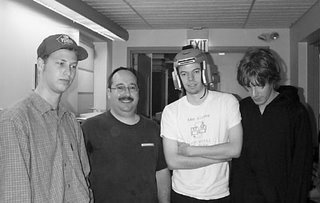 "the 8-bit construction set" was a project i started work on in 1998 and ended as a collaboration between four people: myself, cory, joe beuckman and joe bonn. usually our collaborations are produced under the name BEIGE, but in this case the 8-bit construction set was my band and our self-titled record. "
"the 8-bit construction set" was a project i started work on in 1998 and ended as a collaboration between four people: myself, cory, joe beuckman and joe bonn. usually our collaborations are produced under the name BEIGE, but in this case the 8-bit construction set was my band and our self-titled record. "
P.D.
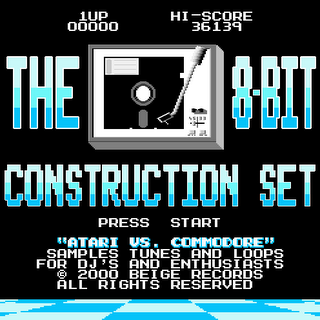
Update #2 (from
Anders Carlsson aka GOTO80)
Demos are not hacked game animations, it's something programmed, composed, illustrated and animated usually 100% by a group of hobby computernerds. This is the oldschool style of it - still being used in the demoscenes of C64, Gameboy, Atari, Amiga, etc - whereas today the modern demoscene, using Windows and all, uses pre-defined graphical/3D stuff.I'm not sure what you mean with chiptune, and I'm not even sure what I mean haha, but maybe you're right that the record-released chipmusic started in 1999. But, to be exact it didn't even start in the demoscene though it was there it got developed in th 1990's (in Europe anyway) to get more independent from game-music. It depends on how you define chipmusic ofcourse - which noone seems to be able to do - but making music with soundchips started in the 1950's and was then developed in science, art and videogame discourses I guess.An interesting early commercial chipmusic release is ex Atari Teenage Riot member Alec Empire, who under the name Nintendo Teenage Robot released an album in 1999 completely made with the music program inside the Gameboy Camera.Oh, and I don't live in Stockholm. :)
 Oberzan, Gridley and Johanson
Oberzan, Gridley and Johanson 























